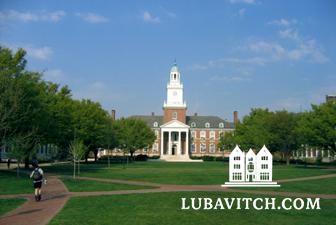In the snazzy Inn at the Colonnade, across the street from Johns Hopkins University, half the assembled crowd clattering across the gleaming marble lobby to attend the campus Chabad’s Yom Kippur services will not be earning degrees. Or teaching. Or have any affiliation with Johns Hopkins.
They come because Chabad has an open door policy. They come because Chabad advertises the time and address of the services in the paper. They come because Rabbi Zev Gopin explains the prayers as they are recited, and keeps things lively. But most of all they come on the holiest day of the year because when Chabad of Johns Hopkins proclaims “A Home for Every Jew” as its motto, it means it.
“Most of our activities focus on the students,” said Rabbi Gopin, “but people come to us year to year who don’t go to shul otherwise. It’s an interesting mix.”
Town and gown conflicts are as old as the quaint tradition that has university students strutting around in Harry Potter gear. It would be reasonable to assume that Chabad on Campus centers would place itself squarely in the universe of gowns, Greeks, and geeks. But many of the 100-plus Chabad centers on campuses across the United States and around the world serve areas where Jewish infrastructure is sparse. When Jews in those areas heed that still small voice within themselves that whispers loudest on the High Holidays, they feel comfortable turning to Chabad.
A few years back, Chana Gopin, co-director of Chabad at Johns Hopkins, would prepare separate meals for the High Holidays. One served students and the other was for the locals, most of whom were at least double the age of the Hopkins kids. “Initially we were hesitant to make it a mixed crowd, but the older people like to hang out with the younger people, and the students enjoy hearing about the experiences of the older people,” said Rabbi Gopin. “There’s no end to the unusual stories that come up.”
Like the one this year, when a woman in her sixties, one of the few female Hopkins’ grad school alumnae (the university was boys only at the undergrad level into the seventies), who selected Chabad as her first point of re-entry into organized religion since the Nixon administration. A genealogy enthusiast, the woman traced her roots to an attic, to a bundle of letters all written in Yiddish. When she found out that her great-great-great-and then some grandfather was none other than Reb Rafael of Pershan, a noted devotee of the first Rebbe of the Chabad-Lubavitch dynasty, Rabbi Schneur Zalman of Liadi–she felt she belonged at Chabad.
That sense of welcome so affected another woman that it caused her to make a request few campus rabbis are likely to hear. Last Rosh Hashanah, a lively bird-boned septuagenarian enjoyed Rabbi Gopin’s talks about the soul so much that she asked him to officiate at her funeral. “She put the instructions about contacting me in her will,” said Rabbi Gopin. “I don’t think I’ll ever hear something like that from a student.”
After four years at Hopkins, the Gopins are also getting used to the effect they have on non-Jewish students. A few days before Rosh Hashanah services, they commemorated September 11th with a Mitzvah Marathon. Students wanting to build a better world on the anniversary of that day of darkness and destruction could sign up for a blood drive, buy a can of food for a food bank, give charity, or the most popular option: make peanut butter and jelly sandwiches for the homeless. Of the 200 students who stepped up to do a mitzvah on the run, more than half were not Jewish. “We provided a way to do good deeds that were appealing to everyone, Jewish or not.”
At the end of the event, Rabbi Gopin packed the last of the sandwiches into a cardboard box and got ready to drive to the plot of land near the post office where the homeless congregate with their cardboard boxes, benches and shopping carts. On his way to the car, a young Asian student sprinted to catch up with the rabbi.
“Are you the rabbi from Shabbat?” he asked, breathless after his chase and too winded (or too misinformed) to recall the difference between “Shabbat” and “Chabad”. Rabbi Gopin’s answer in the affirmative brought a smile to the student’s face and a request. The student wanted to do something positive for September 11th , and Chabad’s approach to the day appealed to him the most.
There was no peanut butter left, and the blood drive forms were put away. No matter, the student said, he’d give charity. And that’s how Rabbi Gopin’s September 11th Mitzvah Drive ended up with its biggest donation of the day.
When Chabad sets about to be a lamplighter to brighten the world, there’s no telling where those rays of goodness and kindness will spread.

Be the first to write a comment.